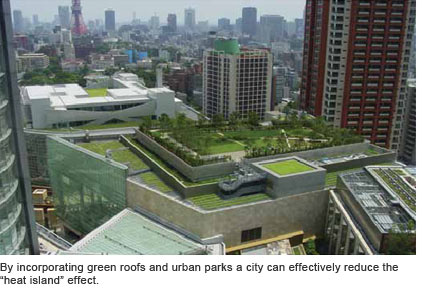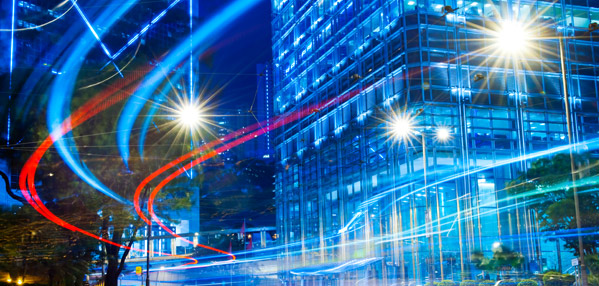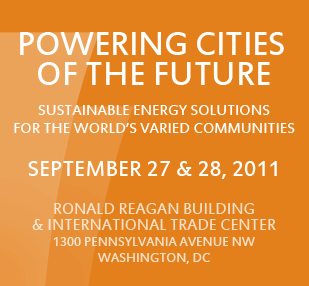By Dave Robau
  hen we think of a typical urban core, we think of traffic snarls with single-car drivers, pollution, and noise. While half of the world’s population lives in these urban areas, these sectors are consuming about three quarters of the world's resources. This unsustainable model is a disaster in the making. hen we think of a typical urban core, we think of traffic snarls with single-car drivers, pollution, and noise. While half of the world’s population lives in these urban areas, these sectors are consuming about three quarters of the world's resources. This unsustainable model is a disaster in the making.
According to the National Resources Defense Council, by the year 2050 urban growth will continue to escalate, resulting in 89 million homes and 190 billion square feet of retail and other non residential space, in the United States alone.
Air pollution is a growing concern for cities big and small so it’s no surprise that across the globe air managers and city planners are working to combat pollution with a great sense of urgency.
Historically, those wanting to leave behind this pollution and traffic have fled the downtown areas for the suburban life and the promise of clean air and healthy living. This phenomenon has given rise to urban sprawl and has resulted in longer commutes and more air emissions from the tailpipes.
As our populations spread outward into the hinterlands an auto-dependent society emerges and with that comes an increase in fossil fuel emissions. So how do we design and build a city that meets the needs of its residents and leaves a positive and lasting impression on the planet? Is a carbon-neutral city even possible?
First, we need to examine some basic concepts to frame the discussion and identify some very basic elements that are necessary for a modern, sustainable city that can respond to population growth and the increased demand on natural resources.
These critical areas are: energy & emissions, transportation, water, waste and materials selection, and food production.
And while these issues are the concern of urban planners, municipal leaders and businesses everywhere, the type of Eco-Utopia envisioned by some is still over the horizon, albeit with projects like Abu Dhabi’s Masdar City spending many billions of dollars in an effort to make the ideal real.
Energy & Emissions
Energy is an absolute necessity. It powers our infrastructure and fuels our entire economy. Without it our cities would cease to exist. However, by focusing on energy conservation and adopting sustainable building concepts and low impact development techniques, we can effectively reduce the energy demand and subsequently curb pollution.
Dockside Green, a LEEDPlatinum mixed-used community, has been recognized globally as a leader in sustainable community design. The project is located in Victoria, British Columbia, and defines the path towards a bright and sustainable future.
By incorporating green roofs and urban parks, Dockside Green can effectively reduce the “heat island” effect, which can increase the temperature in a city core by 10 degrees Fahrenheit.
Transportation
A strong, multimodal transportation network is a critical aspect of any functional city. A well-planned system is designed to move people and goods in and around a city efficiently and in a way to allow for adequate capacity to sustain population increases and eliminate the pollution associated with traditional methods.
Masdar City serves as a unique example for renewable energy and clean technology applications (www.masdarcity.ae). The transportation planning goals of Masdar City are truly impressive and call for a zero-carbon footprint using a multimodal transportation system to connect Masdar City to Abu Dhabi’s International Airport and surrounding areas.
Water
Water is the essence of life and it is becoming increasingly more expensive to meet the growing demand for it. The USEPA estimates that 36 states will face water shortages by 2013. By adopting green infrastructure, the cities of the future will store, treat and reuse water for many purposes, including potential reuse to supplement drinking water.
Seattle’s King Street Center uses rainwater for toilet flushing and irrigation. The system provides 60 percent of the annual water needed for toilet flushing, conserving approximately 1.4 million gallons of potable water each year.
Investing in this type of green infrastructure has a strong return on investment. New York City’s 2010 Green Infrastructure Plan estimates that every fully vegetated acre of green infrastructure will lead to $8,522 in reduced energy demand, $166 in reduced CO2 emissions, $1,044 in improved air quality, and $4,725 in increased property value.
Waste & Materials Selection
The cities of the future will all implement comprehensive waste management strategies to include material selection. If a material cannot be readily recycled or composed the city simply does not purchase it. This type of buying power can help to transform the entire packing industry.
Eco-Utopia and other cities like it will utilize advanced waste-to-energy gasification facilities as a cost effective means of turning municipal solid waste (and many other waste streams) into energy, mainly electricity and even fuel (using the Fischer-Tropsch process). This technology can also be applied to heating water for domestic or industrial uses.
The United States Air Force has taken on a new initiative to contain all of the municipal solid waste generated at one of its installations as part of a beta test to treat the entire waste stream on-site. If the test proves to be successful, it may be replicated at other military installations.
Urban Food Production
City planners are working feverishly to redesign the downtown streets capes to feature mixed-use developments with a walkable urban layout to put residents in proximity to employment sectors, retail stores, recreation and entrainment. What is often left out of the conversation is food production.
Produce and other food supplies are harvested sometimes thousands of miles from your dinner table. Getting this food to you often involves lots of fuel and lots of pollution.
A truly sustainable city will have the means to produce food by implementing vertical farming techniques.
Vertical farming is in-city food production incorporated into a city’s high-rise buildings. It represents the vision of future sustainable food production, accommodating for the growing number of people living in future cities.
The idea of vertical farming is sustainable on several levels, in terms of energy, water, transport and waste but also in terms of organically produced food. The first vertical farming project is still on the horizon.
Sustainable Urbanism: Eco-Utopia, USA
Eco-Utopia aims to reduce or eliminate fossil-fuel use, adopt sustainable building practices, promote green space and clean air, implement energy-efficient and widely available public transportation, create walkable cities and develop wellorganized mixed-use neighborhoods that combine living, working and shopping.
These qualities add up to sustainable urbanism, which gave rise to the concept of Smart Growth that will avoid urban sprawl.
The goal of smart growth is to implement regional considerations of sustainability to achieve a unique sense of community and place.
Through this process, planners expand the range of transportation, employment, and housing options. Low impact development strategies help to quantify the benefits of sustainable development, while preserving and enhancing natural and cultural resources and promote public health.
Smart city planning will help elected officials and city managers implement best practices in city planning by focusing on green infrastructure to help communities improve air quality and human health.
This proactive, long-range vision can create economic prosperity, lower the demand on energy and water by conserving resources, and ultimately make cities more resilient to the effects of climate change.
Dave Robau is an environmental scientist and LEED Green Associate with the U.S. Air Force Special Operations Command
|


